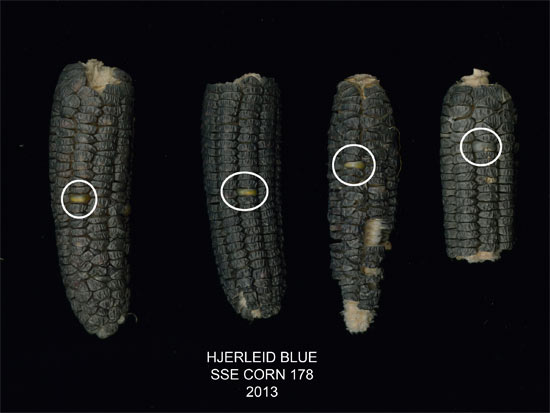Saving heirloom corn from GMO contamination
By Arianne Pfoutz
Published: January 31, 2014
Category: GMO Contamination

Photo courtesy of Seed Savers Exchange.
To access all the articles in this month's issue of The Organic & Non-GMO Report, SUBSCRIBE NOW.
Preserving heirloom seeds is a life-affirming action—ensuring a continued supply of healthy, genetically diverse foods amid external challenges such as climate shifts.
But that task is increasingly difficult for growers and seed savers, particularly with corn. The near omnipresence of genetically modified corn—88% of US corn—is causing contamination of non-GMO, organic, and heirloom corn varieties, with irreversible damage to the genetic purity of these valuable agricultural and cultural assets.
Genetic diversity and history are both lost with the disappearance of heirlooms. Corn varieties such as Navajo Robin’s Egg—a white kernel with bright lavender and blue dots—carry Native American stories with them.
Corn, a wind-pollinated crop, is particularly vulnerable to contamination—the pollen from its tassels can travel for miles. As heirloom seed companies grow out their varieties, even a 10-mile buffer zone is not immune to cross-pollination. Some recommend 25 to 50 miles.
Historic varieties disappearing
According to Jere Gettle, founder of Baker Creek Heirloom Seeds in Mansfield, Missouri, “Over fifty percent of the heirloom corn varieties we have tested appear to be contaminated with GMO crops—so we won’t offer them. In some cases, this means a loss to the country as a whole. In the Midwest where GM corn is rampant, farmers can’t find land far enough away from GM fields. Many growers aren’t willing to take the risk.”
Gettle added that the varieties could potentially be recovered from backup seed in a bank, with GMO testing on every plant, but it’s expensive and time-consuming.
“We currently have 12 to 14 varieties for sale—down from 24 to 25 ten years ago,” he added.
Baker Creek trials about 200 corn varieties, and grows out 100 for seed production. “But contamination is everywhere – it’s hard to find totally pure seed to start with,” Gettle said. He is exploring the cost of hiring hand pollinators to pollinate 50 varieties each year.
Seed Savers Exchange of Decorah, Iowa (SSE) had a surprising contamination event this fall with its Hjerleid Blue—a blue sweet corn grown since the 1940s. Although plantings were protected with a half-mile buffer zone and woods and cliffs, suspicious kernels were found on six different ears of the 200 plants, detectable because they were white. Contamination affected 0.1% of this generation.
“For…non-GMO food labeling, the level of contamination…is acceptable,” wrote Tor Janson and Steve Carlson of Seed Savers. “But for the purposes of saving seed, any GMO contamination is unacceptable because the contamination will increase exponentially in each successive generation.”
Fedco Seeds of Waterville, Maine first discovered GMO contaminated corn in 2008, one year after Monsanto’s Bt corn was approved in the state. This impacts heavily the many organic dairy farmers in Maine, who rely on GMO-free feed. “It’s getting hard to find an area where farmers can grow non-GMO corn,” said Nikos Kavanya of Fedco. “We like to list 5 or 6 open-pollinated varieties each year, but we can’t find the land.”
Native Seeds/SEARCH of Tucson, Arizona preserves 573 varieties of corn, from 50 Southwestern tribes, dating back thousands of years. Original seed is regrown as part of the conservation process. Founder Bill McDorman says the 60-acre conservation farm hasn’t seen any contamination from GMOs so far. “We hand pollinate—it’s way more effective,” he said.
Solutions to prevent contamination
Seed Savers Exchange also recommends hand pollination, especially in the industrial corn belt. This involves putting bags over ears before silks emerge, bagging tassels, collecting the pollen and hand pollinating the silks on each ear. It’s time consuming and labor-intensive. SSE also suggests growing only one variety each year, and growing varieties with dramatically different days-to-maturity. It also helps to grow varieties where GMO contamination is visually apparent, such as white or blue corn.
High Mowing Seeds of Vermont takes four steps to make sure GM traces don’t enter the food supply: control of the seed stock; inspection of growing fields and distance from GM crops; harvesting and cleaning with equipment specified for organic; and testing incoming seed for GMOs.
Solutions going forward—some positive signs
While most seed saving companies agree the problem is getting worse, Gettle is encouraged that more people are engaged in solving the problem.
Frank Kutka of North Dakota State is working on development of a corn variety, using traditional breeding techniques, that won’t accept GM pollen or pollen from other varieties.
In the past year, 140 new seed libraries opened, a public resource where growers can check out varieties for free. And New Mexico congresswoman Michelle Grisham proposed the Native American Seed Protection Act; if passed, the USDA would help tribes safeguard their seeds.
“The key is keeping agriculture small and sustainable,” McDorman said. Meanwhile, he garnered a tip from Monsanto. His non-profits’s seed packets now carry a warning: “Any seeds obtained from Native Seeds/SEARCH are not to be used for commercial breeding purposes with a patent outcome unless there are written agreements with the originators of the seeds in Native Seeds/SEARCH’s collection.”
© Copyright The Organic & Non-GMO Report, February 2014




